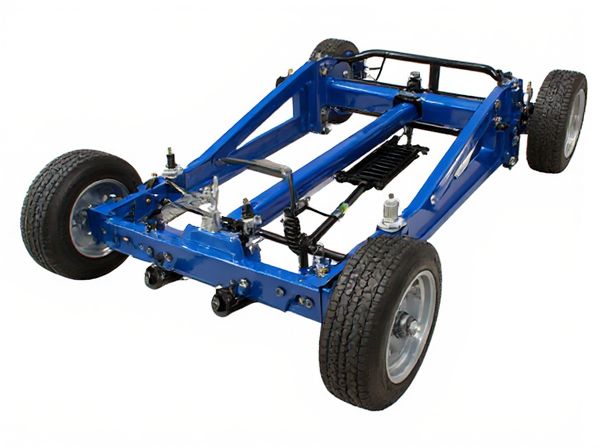
Photo illustration: Short Rack Steering vs Long Rack Steering
Short rack steering offers quicker response and greater steering feedback, ideal for performance-focused driving and tight maneuvers. Long rack steering provides smoother, more stable control suitable for highway driving and comfort over long distances. Your choice depends on whether you prioritize agility or stability in your vehicle's handling.
Table of Comparison
| Feature | Short Rack Steering | Long Rack Steering |
|---|---|---|
| Steering Response | Quick and precise | Smoother, less sensitive |
| Turning Radius | Tighter turns | Larger turning radius |
| Installation Space | Compact design, limited space needed | Requires more space in chassis |
| Compatibility | Common in performance and sports cars | Found in standard and larger vehicles |
| Steering Effort | Higher effort at low speeds | Lower effort, easier steering |
| Durability | Potentially increased wear due to compact parts | Generally more durable |
| Cost | Typically higher cost | Generally more affordable |
Introduction to Rack Steering Systems
Rack steering systems are essential components in automotive steering, translating the rotational movement of the steering wheel into linear motion to turn the wheels. Short rack steering offers quicker response and typically suits compact vehicles, whereas long rack steering provides smoother control and better leverage, ideal for larger or off-road vehicles. Understanding the differences between short and long rack systems helps optimize steering performance based on vehicle size and driving conditions.
What is Short Rack Steering?
Short rack steering features a compact steering rack with a shorter stroke length, enhancing responsiveness and steering precision in tight, urban driving conditions. This system allows for quicker wheel turns with less steering input, making it ideal for vehicles requiring sharp maneuverability or sporty handling characteristics. Its design contrasts with long rack steering, which provides smoother handling over longer wheel turns suited for highway or off-road use.
What is Long Rack Steering?
Long rack steering refers to a steering system configuration where the steering rack is extended longer than the standard or short rack setup, providing increased leverage and finer control over wheel movement. It enhances steering response by allowing more precise adjustments to the angle of the wheels, improving handling, especially in performance and off-road vehicles. This design also helps accommodate wider vehicle tracks and custom suspension geometries, making it a preferred choice in motorsports and specialized automotive applications.
Key Differences Between Short and Long Rack Steering
Short rack steering offers quicker steering response and greater sensitivity, ideal for tight maneuvering and performance driving, while long rack steering provides smoother, more stable control at higher speeds, suitable for highway driving. The primary difference lies in the length of the steering rack which affects the steering ratio, with short racks delivering a lower ratio for rapid wheel movement and long racks offering a higher ratio for precision and comfort. Vehicle application, driver preference, and road conditions are critical factors in choosing between short rack and long rack steering systems.
Performance Impacts: Handling and Responsiveness
Short rack steering systems typically offer quicker steering response and enhanced handling precision due to their reduced steering ratio, making them ideal for performance-driven vehicles requiring agile maneuverability. Long rack steering setups provide smoother, more gradual steering inputs, which can improve stability at high speeds but may result in less immediate feedback and slower responsiveness. The choice between short and long rack steering directly influences vehicle dynamics, with short racks favoring sharp cornering and long racks supporting balanced control on highways.
Suitability for Different Vehicle Types
Short rack steering systems are ideal for compact vehicles and sportier cars due to their quicker steering response and tighter turning radius, enhancing maneuverability in urban environments. Long rack steering is better suited for larger vehicles such as trucks and SUVs, providing smoother and more stable steering control over rough terrain and at higher speeds. Selecting the appropriate rack length depends on vehicle size, intended use, and desired steering precision.
Durability and Maintenance Considerations
Short rack steering systems generally offer enhanced durability due to their compact design and fewer exposed components, reducing wear and tear from environmental factors. Long rack steering, while potentially providing slightly smoother steering input over a broader range, often requires more frequent maintenance because its extended components are more susceptible to damage and alignment issues. Choosing short rack steering can lead to lower long-term maintenance costs and increased reliability in demanding driving conditions.
Cost Implications of Steering Rack Choice
Choosing between Short Rack Steering and Long Rack Steering significantly impacts overall vehicle maintenance and production costs. Short Rack Steering systems generally offer lower initial manufacturing expenses due to reduced material usage and simpler design, while Long Rack Steering may incur higher costs because of extended components and increased complexity. Repair and replacement costs tend to be higher with Long Rack Steering, as longer racks are more susceptible to wear and require more labor-intensive servicing.
Popular Applications: Racing vs. Street Driving
Short rack steering provides quicker steering response and is favored in racing applications due to its enhanced agility and precision during high-speed maneuvers. Long rack steering offers smoother, more gradual steering input ideal for street driving, prioritizing comfort and ease of control in everyday traffic conditions. Racing vehicles often employ short racks to achieve tighter cornering, while daily drivers benefit from long racks for stability and predictable handling.
How to Choose Between Short and Long Rack Steering
Choosing between short rack steering and long rack steering depends on the vehicle's intended use, space constraints, and steering response preference. Short rack steering offers quicker, more responsive handling ideal for tight maneuvers and performance vehicles, while long rack steering provides smoother steering input and is better suited for larger vehicles requiring stability. Evaluating factors such as steering ratio, vehicle size, and driving conditions ensures the optimal choice for control and comfort.
 caratoz.com
caratoz.com